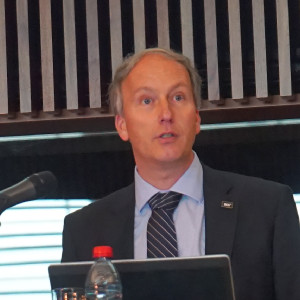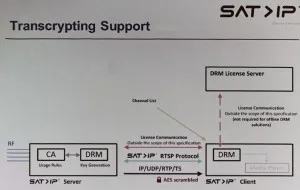The second day started with more technical content on broadcast and then moved into a session on SAT>IP. We have been reporting on the concept (where satellite-supplied content is put straight into a home network – even as early as the LNB).
 Tom Christophory is from SES and is the “technical guru” behind SAT>IP and he looked at the roadmap and the current status. His talk went at lightning speed!
Tom Christophory is from SES and is the “technical guru” behind SAT>IP and he looked at the roadmap and the current status. His talk went at lightning speed!
There have been a number of new developments in SAT>IP including an IP client STB from Kathrein and a TV from Panasonic that has a server and a client inside. A server has been developed that supports up to 32 channels to allow use in small hotels. Multiple servers can also be stacked for more channels. Humax has a small STB with a SAT>IP client. Selfsat has an 8 channel flat antenna (of which, more later).
In 2015, Philips (TPVision) will have a TV with a SAT>IP client. Panasonic will have a Blu-ray recorder that can act as a SAT>IP server. New LNBs and multiswitches and a single chip SAT>IP server from Broadcom are being finalised.
At NAB, a new SAT>IP Alliance was announced to open up the ecosystem to other operators and developing a neutral technology as, in some quarters, there was concern that it might be too dominated by SES alone.
Hispasat has joined the new Alliance along with Panasonic, and MaxLinear, Ali and Nagra are members. Other satellite operators are expected to join and other companies can join.
The Alliance will work on development, marketing, licensing and certification and the annual fee is €5,000.
Although SAT>IP is well known in the industry, the understanding has not grown outside the industry to installers, retailers and consumers, so more marketing is needed. That is regarded as a critical part of the function of the Alliance.
The original specification was developed by Sky and SES and the Alliance will propose that the next update will go to Cenelec (which certified the earlier version). No radical changes are needed and there are plenty of features in the first specification that have not been exploited yet.
New options will be considered for compliance testing and certification by the Alliance, and an independent testing house will probably be certified and approved to offer test services.
Christophory then moved onto developments in the standard. Encryption has been through conditional access (CA) in the past and its moving to DRM technologies, so the support needs to be added.
Video and audio transcoding is already supported by some servers, but the new extensions will allow the client to request content transcoded into a specific format, whereas the current implementations are server driven. This work is almost done, as it’s a simple change.
Transcrypting is more complex as there are multiple use cases and technologies. The client can ask the server what content is available and with what protection and could then request a particular scheme.
One possible solution is to use encrypted ip and the group is looking at that as a candidate feature.
The FreeTV Alliance (a group of European broadcasters interested in possibly using SAT>IP and including FreeSat, FranSat, tivusat and HD+) is also looking for new encryption features.
Other changes include the adding of DVB T2/C2 and S2, so SAT>IP is no longer limited to satellite content, but also terrestrial and cable. There is a new simple unicast-only profile which simply broadcasts to all devices, which makes server design easier. If a server has a channel list, it can now be downloaded by the client, which means no list has to be created. The server can scan or download a channel list from the internet.
Servers are still too expensive, Christophery said, so there is a need for single chip servers (and one is on its way from Broadcom).
Servers are complex, but the testing process has been robust, so the current servers in the market are good and work well. The client devices were thought to be simple, but has turned out to be more complicated. SAT>IP can’t improve weak DVB implementations, Christophery commented. There need to be better user interfaces on the clients, but at the moment, the work has tended to be just in getting things working, rather than getting them working with high quality and ease of use.
SES thinks a layered approach to the software stack on the client would be helpful and is looking to work with partners to develop this.
Thomas Wrede said that SES has invested quite a lot of money to run some trials to get more user feedback on the system so that changes and marketing can be better targeted.

